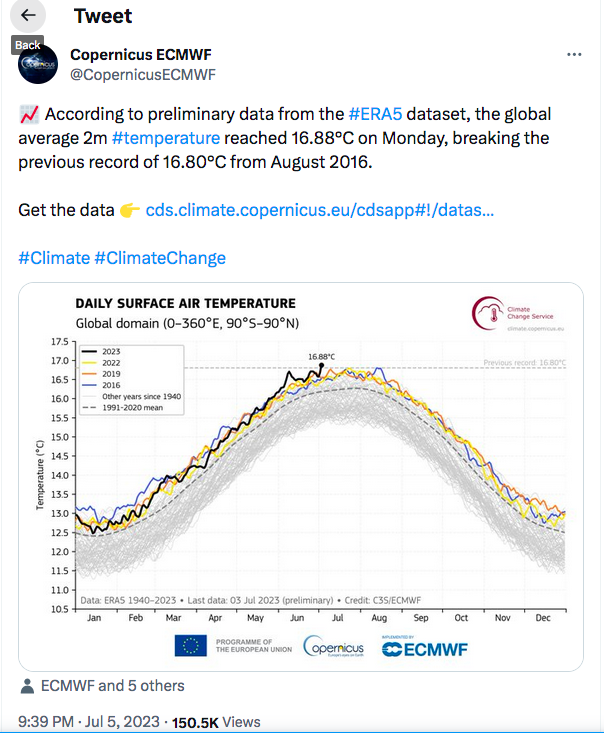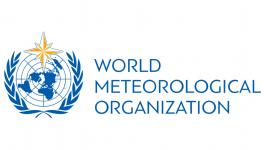A June of Records: Record Temperature at Land, Sea Surface; Lowest Sea Ice Content Level

Image Courtesy: Wikimedia Commons
This year’s June likely has seen the real-time impact of climate change manifested in extreme weather conditions—the highest temperature ever recorded in the month, sea surface temperature reaching a new high and a record level of low ice content in Antarctica. This alarming information has been revealed in the latest report of the Copernicus Climate Change Service (CCCS) of the European Union, published on July 6. The CCCS is a close collaborator of the World Meteorological Organization (WMO). The alarming extreme weather conditions show the profound changes the Earth's system faces as an immediate consequence of anthropogenic or man-made climate change.
According to the report, June 2023 saw a record temperature of 0.5 degrees Celsius higher than the 20 average during 1991-2020. The global average sea surface temperature also touched an unprecedented high in the month of June. The North Atlantic sea surface temperature was exceptionally high, with several extreme marine heat waves. The data showed that the North Atlantic sea surface temperature had risen steadily since May and peaked on June 21, recording 1.6 degrees Celsius above the average level.
ALL-TIME HIGH TEMPERATURE RECORDED IN JULY
The extreme heat conditions continued till the first half of July. In fact, July 3 became the hottest day to have been recorded ever since the temperature recording started. The Copernicus ECMWF ERA5 dataset suggests that the global average temperature touched 16.88 degrees Celsius that day, which broke the previous record of 16.80 degrees Celsius in August 2016.

The Copernicus ECMWF ERA5 Data showing the record temperature on July 3.
WMO director of climate services, Prof. Chris Hewitt, in a comment about the record high temperature, said, “The exceptional warmth in June and at the start of July occurred at the onset of the development of El Niño, which is expected to further fuel the heat both on land and in the oceans and lead to more extreme temperatures and marine heatwaves. We are in uncharted territory, and we can expect more records to fall as El Niño develops further, and these impacts will extend into 2024. This is worrying news for the planet.”
The global sea surface temperature remaining high during May and June may impact marine lives and ocean circulation adversely. Prof. Hewitt also warned that it is not only the surface temperature. In fact, the ocean is getting warmer, which means absorbing more energy that will continue to stay there for quite a long time, even for hundreds of years. Marine heatwaves of extreme character were also observed in Ireland, the UK, and the Baltic Sea.
Record temperatures in June were observed across northwest Europe, along with parts of Canada, the US, Mexico and Asia having higher temperatures than normal. On the other hand, western Australia, the western US, and western Russia were cooler than normal.
Extreme heat waves killed over 44 people in North India in June. China also experienced unprecedented heat waves that led to recording the country's highest number of hot days.
Thomas Smith, an environmental geographer at the London School of Economics (LSE), commented in an article by Katharine Sanderson published in Nature, “It’s warmer than ever before. All of these underlying trends are driven by extra greenhouse gases in the atmosphere, which also impact ocean surface temperatures because they receive infrared energy from the atmosphere.”
LOW SEA ICE CONTENT
June also recorded the lowest extent of Antarctic sea ice, 17% below average since satellite observation began worldwide. The report said that the daily sea ice level of the Antarctic remained at an unprecedented low level throughout the month. June is the middle of winter in Antarctica, and the record low level of the ice content is quite well an indicator for pressing the climate emergency button.
On the other hand, the Arctic sea ice content was a little better. Although it went slightly below the average level, it remained above the level recorded in June in the past eight years. Caroline Holmes of the British Antarctic Survey in Cambridge, UK, commenting on Katherine Sanderson’s article, warned that, seeing the recent history, it is hard to expect the sea ice content to bounce back much in the next year. “Not only is Antarctic sea ice at an extreme and record low for June, but this comes on the back of several record low months in the past 18 months,” Caroline commented. She added, “Sea-ice loss matters for multiple ecosystems which rely on the sea ice, and particularly on the timing of its annual freeze and melt, which are now so disrupted.”
Apart from these extreme weather conditions that June 2023 recorded, there were also massive wildfires in Canada. With temperature rising upto 14 degree Celsius higher than average for June, the wildfires resulted in emitting carbon greater than the amount usually released during the entire season of wildfires. The usual season of wildfires in Canada is July or the early part of August. This means that this year’s wildfire season is not over, and the possibility of releasing even more carbon into the atmosphere remains.
Get the latest reports & analysis with people's perspective on Protests, movements & deep analytical videos, discussions of the current affairs in your Telegram app. Subscribe to NewsClick's Telegram channel & get Real-Time updates on stories, as they get published on our website.




















